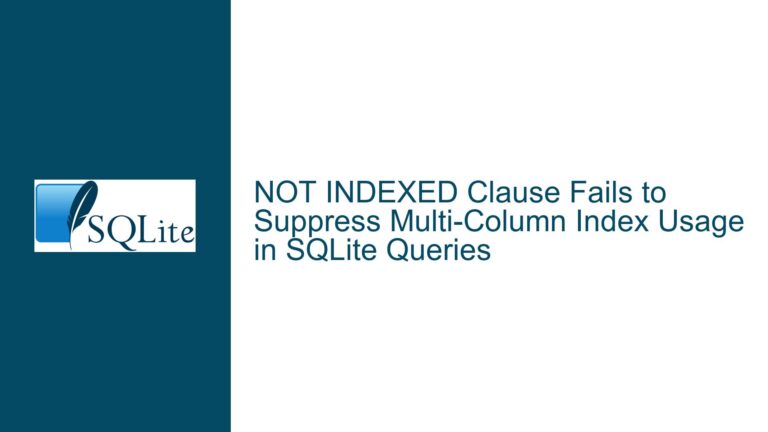SQLite Schema Design and Query Optimization for Book-Author Relationships
Issue Overview: Schema Design and Query Optimization for Book-Author Relationships
The core issue revolves around designing an efficient and maintainable SQLite schema to manage relationships between books and authors, along with writing queries to retrieve aggregated data such as books and their corresponding authors in a specific format. The initial schema provided in the discussion lacks proper constraints, normalization, and optimization, leading to potential inefficiencies and data integrity issues. Additionally, the queries need to be refined to handle edge cases, such as books without authors or authors without books, and to ensure the output is formatted correctly.
The schema involves three tables: book, author, and book_author. The book table stores book details, the author table stores author details, and the book_author table acts as a junction table to manage the many-to-many relationship between books and authors. The primary challenge is to ensure the schema adheres to best practices, such as proper normalization, constraints, and indexing, while also writing queries that can handle complex aggregations and edge cases.
The desired output is a list of books with their corresponding authors, formatted as a concatenated string of author names for each book. For example:
Science|Harry Potter
Math|Ron Weasley,Hermione Granger
History|Hermione Granger
Filipino|Hermione Granger
English|Harry Potter,Hermione Granger
Possible Causes: Schema and Query Design Flaws
Lack of Proper Constraints and Normalization:
- The initial schema does not enforce uniqueness on the
namecolumns in thebookandauthortables, which could lead to duplicate entries and data integrity issues. - The
book_authortable does not enforce foreign key constraints, which could result in orphaned records if a book or author is deleted. - The
book_authortable includes an unnecessaryidcolumn, which adds overhead without providing any meaningful functionality.
- The initial schema does not enforce uniqueness on the
Inefficient Query Design:
- The initial queries do not account for edge cases, such as books without authors or authors without books.
- The queries do not use proper aggregation techniques to concatenate author names for each book, leading to inefficient and incorrect results.
- The queries do not leverage views or common table expressions (CTEs) to simplify complex logic and improve readability.
Missing Business Rules:
- The schema does not account for business rules, such as whether a book can exist without an author or an author can exist without a book. This omission leads to incomplete query results and potential data inconsistencies.
Lack of Indexing and Optimization:
- The schema does not include indexes on the
book_idandauthor_idcolumns in thebook_authortable, which could lead to slow query performance, especially as the dataset grows. - The queries do not use advanced SQLite features, such as
WITHOUT ROWIDtables orNATURAL JOIN, which could improve performance and maintainability.
- The schema does not include indexes on the
Troubleshooting Steps, Solutions & Fixes
Step 1: Refine the Schema Design
The first step is to refine the schema to ensure it adheres to best practices for normalization, constraints, and optimization. Here is the revised schema:
-- Define the book table with proper constraints
CREATE TABLE book (
book_id INTEGER PRIMARY KEY,
name TEXT NOT NULL COLLATE NOCASE UNIQUE
);
-- Define the author table with proper constraints
CREATE TABLE author (
author_id INTEGER PRIMARY KEY,
name TEXT NOT NULL COLLATE NOCASE UNIQUE
);
-- Define the book_author table with proper constraints and WITHOUT ROWID optimization
CREATE TABLE book_author (
book_id INTEGER NOT NULL REFERENCES book (book_id),
author_id INTEGER NOT NULL REFERENCES author (author_id),
PRIMARY KEY (book_id, author_id),
UNIQUE (author_id, book_id)
) WITHOUT ROWID;
Key Improvements:
- The
bookandauthortables now enforce uniqueness on thenamecolumns using theUNIQUEconstraint, preventing duplicate entries. - The
book_authortable usesWITHOUT ROWIDto optimize storage and performance, as theROWIDis unnecessary for this table. - Foreign key constraints are added to the
book_authortable to ensure referential integrity between thebookandauthortables. - The
book_authortable includes a composite primary key on(book_id, author_id)and a unique constraint on(author_id, book_id)to enforce data integrity and improve query performance.
Step 2: Insert Sample Data
Next, insert sample data into the tables to test the schema and queries:
-- Insert sample data into the book table
INSERT INTO book (name) VALUES
('Science'),
('Math'),
('History'),
('Filipino'),
('English');
-- Insert sample data into the author table
INSERT INTO author (name) VALUES
('Harry Potter'),
('Ron Weasley'),
('Hermione Granger');
-- Insert sample data into the book_author table
INSERT INTO book_author (book_id, author_id) VALUES
(1, 1),
(2, 2),
(2, 3),
(3, 3),
(4, 3),
(5, 1),
(5, 3);
Step 3: Write Queries to Retrieve Aggregated Data
The next step is to write queries to retrieve the desired output, which includes concatenating author names for each book. Here is the revised query:
-- Query to retrieve books and their corresponding authors
SELECT
B.name AS Book,
GROUP_CONCAT(A.name, ', ') AS Authors
FROM
book_author AS L
JOIN
book AS B ON B.book_id = L.book_id
JOIN
author AS A ON A.author_id = L.author_id
GROUP BY
B.name
ORDER BY
B.name DESC;
Key Improvements:
- The
GROUP_CONCATfunction is used to concatenate author names for each book, separated by commas. - The
GROUP BYclause ensures that the results are grouped by book name. - The
ORDER BYclause sorts the results in descending order by book name.
Step 4: Handle Edge Cases with Views
To handle edge cases, such as books without authors or authors without books, create a view that emulates a full outer join:
-- Create a view to handle books without authors and authors without books
CREATE VIEW all_books AS
SELECT
B.book_id,
B.name AS book_name,
A.author_id,
A.name AS author_name
FROM
book AS B
LEFT JOIN
book_author AS L ON B.book_id = L.book_id
LEFT JOIN
author AS A ON A.author_id = L.author_id
UNION
SELECT
NULL AS book_id,
NULL AS book_name,
A.author_id,
A.name AS author_name
FROM
author AS A
WHERE
NOT EXISTS (
SELECT 1
FROM book_author AS L
WHERE A.author_id = L.author_id
);
Key Improvements:
- The view uses
LEFT JOINto include books without authors and authors without books. - The
UNIONclause combines the results of two queries: one that retrieves books with authors and another that retrieves authors without books. - The view ensures that all books and authors are included in the results, regardless of whether they have corresponding entries in the
book_authortable.
Step 5: Optimize Query Performance
To optimize query performance, create indexes on the book_id and author_id columns in the book_author table:
-- Create indexes on the book_author table
CREATE INDEX idx_book_author_book_id ON book_author (book_id);
CREATE INDEX idx_book_author_author_id ON book_author (author_id);
Key Improvements:
- Indexes on the
book_idandauthor_idcolumns improve query performance by allowing the database to quickly locate matching records in thebook_authortable. - The indexes are particularly useful for large datasets, where query performance can degrade without proper indexing.
Step 6: Test and Validate the Schema and Queries
Finally, test and validate the schema and queries to ensure they produce the desired results and handle edge cases correctly:
-- Test the all_books view
SELECT * FROM all_books;
-- Test the query to retrieve books and their corresponding authors
SELECT
B.name AS Book,
GROUP_CONCAT(A.name, ', ') AS Authors
FROM
book_author AS L
JOIN
book AS B ON B.book_id = L.book_id
JOIN
author AS A ON A.author_id = L.author_id
GROUP BY
B.name
ORDER BY
B.name DESC;
Key Improvements:
- The
all_booksview ensures that all books and authors are included in the results, regardless of whether they have corresponding entries in thebook_authortable. - The query produces the desired output, with books and their corresponding authors formatted as a concatenated string.
By following these steps, you can design an efficient and maintainable SQLite schema for managing book-author relationships and write queries that handle complex aggregations and edge cases. The refined schema and queries ensure data integrity, improve performance, and provide a solid foundation for future enhancements.






